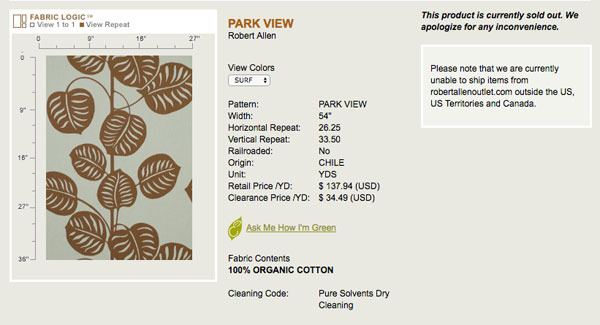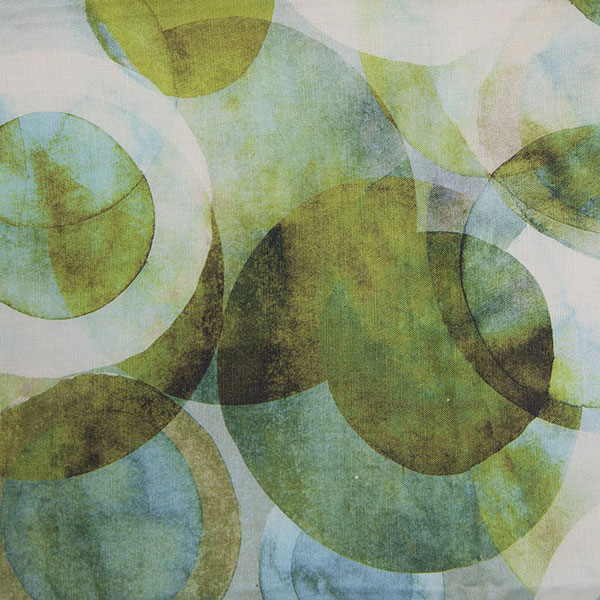‘Purely natural’ fibers remain an anomaly
in the world of upholstery fabrics, so it took some digging to find the showrooms that had them on offer inside the Boston Design Center.

Inquiring on behalf of chemically sensitive clients
At each stop where only chemical-treated options were available, I pressed the question: “Why aren’t toxin-free fabrics more readily available to the upholstery industry?” The answer I received will be all-too-familiar for those seeking relief from health challenges associated with home-environmental toxins: “There just is not enough demand for them.”
Case in point: About a decade ago ago (circa 2008), Robert Allen offered an ‘organic’ line of fabrics, which has since been discontinued. Today you might be excited to run across their Eco-Friendly page, only to discover that all of the fabrics in that category are out of stock and discontinued.

Hope for the weary
After inquiring at a few of the better-known fabric showrooms, I finally arrived at The M-Geough Company, where they had a section dedicated to fabric lines that could be purchased without ‘treatment’ (meaning ‘no chemicals’). Even here, you had to double check the label and often the fabric would have to be special ordered to receive a completely chemical-free product. Here are some of the fabric companies they represent which offer toxin-free options:
Filippo Uecher – I especially loved the Attis pattern, which is 100% linen:

Calvin Fabrics – carries linens & cottons
Jacques Bouvet et Cie -carries linens & cottons
Johnstons of Elgin – Tingwall pattern, which is 100% wool:

Note: purchase of these fabrics requires a trade account, which means you must order through an upholsterer or designer who can purchase the fabric for you.
As usual, you’ll be hard-pressed to find a wide variety of brighter colors in these fabrics, but it’s comforting to know that you’re not getting unwanted chemicals.
Addendum: What exactly IS ‘chemical-free’?
After posting this, I received this comment which prompted me to re-evaluate my perspective:
“I’m curious about what you class as ‘chemical free’? What do you include within your definition? Do you include pesticides during production? Dyeing processes? I imagine a huge barrier to how to identify these products would be how far removed from the production process even retailers can be.” – Lyndsay
Thank you Lyndsay, for drawing my attention back to the matter at hand. What is most important here is the truth about chemicals in textiles, and in my excitement about expanded fabric options, I realize now that I skimmed the surface on the ‘chemical free’ issue during my search at Boston Design Center.
First off, since this discussion was begun with a focus on ‘purely natural fibers’, let’s put aside all consideration of synthetic fibers.
A Perfect World
In a perfect world ‘chemical free’ means completely free of synthetic or harmful chemicals in the growing, harvesting, and processing of the fibers, all the way through production of the fabric (‘harmful’ meaning hazardous to human health or to any other life on earth). Unfortunately, we do not live in such a world.
I decided to delve into the Oecotextiles Blog to unearth some facts (I have talked with Leigh and have the utmost confidence in her and her sister Patty’s research & knowledge on the subject). The following is paraphrased or quoted from their blog:
Currently, the best way to guarantee the safety of a fabric is to purchase only GOTS or Oeko-Tex certified fabric:
- “GOTS aims to define a universal standard for organic fabrics—from harvesting the raw materials, through environmentally and socially responsible manufacturing, to labeling—in order to provide credible assurance to consumers. Standards apply to fiber products, yarns, fabrics and clothes and cover the production, processing, manufacturing, packaging, labeling, exportation, importation and distribution of all natural fiber products. GOTS provides a continuous quality control and certification system from field to shelf. A GOTS certified fabric is therefore much more than just a textile which is made from organic fibers.”
- Oeko-Tex certifies only that the fabric is safe for human use. So if the fabric is shown to have chemicals below the Oeko-Tex threshold limit values, then it can be certified. Oeko-Tex certification looks only at the end product, not at the growing of the fiber, production of the fabric, or any environmental or social considerations.
The truth is, the fabric industry is one of the most chemical-heavy industries in the world today, and it is unfortunate that the burden of proof often lies with the consumer when it comes to identifying chemicals in the fabrics we live, breathe and sleep next to every day.
I regret to say that none of the fabrics I encountered at the Boston Design Center were GOTS or Oeko-Tex certified (though in my slog through the hundreds of show rooms, I’m sure I could have missed something).
Additional Reading
I recommend the Oecotextiles Blog to learn more about chemicals & sustainability in fabrics and the home. One fabric company that carries GOTS & Oeko-Tex fabrics is Two Sisters Ecotextiles. Do you know of others to add to the list? Please leave a comment below. Thank you!
Subscribe to our mailing list to get monthly updates, tips & projects for natural upholstery!
Hi, I’m curious about what you class as ‘chemical free’? What do you include within your definition? Do you include pesticides during production? Dyeing procesess? I imagine a huge barrier to how to identify these products would be how far removed from the production process even retailers can be.
Thank you Lyndsay, for a well-founded and provocative question, which made me rethink my entire train of thought on ‘chemical free’. Please read the post’s addendum above, in response to your question.
Carla